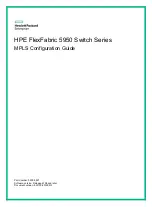
1
0B
Configuring basic MPLS
Multiprotocol Label Switching (MPLS) provides connection-oriented label switching over
connectionless IP backbone networks. It integrates both the flexibility of IP routing and the simplicity
of Layer 2 switching.
14B
Overview
MPLS has the following features:
•
High speed and efficiency
—MPLS uses short- and fixed-length labels to forward packets,
avoiding complicated routing table lookups.
•
Multiprotocol
support
—MPLS resides between the link layer and the network layer. It can
work over various link layer protocols (for example, PPP, ATM, frame relay, and Ethernet) to
provide connection-oriented services for various network layer protocols (for example, IPv4,
IPv6, and IPX).
•
Good
scalability
—The connection-oriented switching and multilayer label stack features
enable MPLS to deliver various extended services, such as VPN, traffic engineering, and QoS.
136B
Basic concepts
317B
FEC
MPLS groups packets with the same characteristics (such as packets with the same destination or
service class) into a forwarding equivalence class (FEC). Packets of the same FEC are handled in
the same way on an MPLS network.
318B
Label
A label uniquely identifies an FEC and has local significance.
Figure 1 Format of a label
A label is encapsulated between the Layer 2 header and Layer 3 header of a packet. It is four bytes
long and consists of the following fields:
•
Label
—20-bit label value.
•
TC
—3-bit traffic class, used for QoS. It is also called Exp.
•
S
—1-bit bottom of stack flag. A label stack can contain multiple labels. The label nearest to the
Layer 2 header is called the top label, and the label nearest to the Layer 3 header is called the
bottom label. The
S
field is set to 1 if the label is the bottom label and set to 0 if not.
•
TTL
—8-bit time to live field used for MPLS loop prevention.
319B
LSR
A router that performs MPLS forwarding is a label switching router (LSR).










































